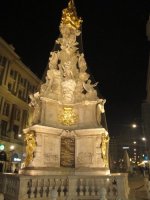Plague art in Vienna
The plague devastated Europe between the 14th and early 18th centuries. It’s estimated that anywhere between a third to over half of Europe’s population died from what was called ‘the Black Death’. Despite the shocking death toll, the plague did lead to positive advances in science, health and urban planning and also left behind stunning examples of art and architecture erected in remembrance of this tragedy. Two examples of “plague art” are popular tourist attractions in Austria’s capital of Vienna.
During the plague in Vienna of 1679, Emperor Leopold I vowed to commemorate Vienna’s eventual deliverance with a plague column. A baroque plague column was commissioned and a young architect, Johann Bernhard Fischer von Erlach, who would later go on to design Schönbrunn Palace and Karlskirche, was tasked with its creation.
The column depicts the plague as an old hag being destroyed by an angel while Emperor Leopold looks on and prays.
The plague column is in the center of the busy pedestrian street of Am Graben and tourists and Viennese pass by it every day, meet friends beneath it, or sit beside it on sunny days at the many cafés offering outdoor seating.
Karlskirche
Vienna’s monumental Karlskirche is the result of a second bout of plague in Vienna, this time in 1713. Emperor Karl VI vowed that, after Vienna was delivered from the plague, he would build a great church dedicated to the 16th century Saint Carlo Borromeo, the patron saint of the plague. Today, the saint’s statue can be seen on the pediment over the church’s main entrance.
 The commission was won by a much older Fischer von Erlach, who had a second chance to provide Vienna with a striking plague memorial. Unfortunately, construction of the Karlskirche would take almost 25 years and Fischer von Erlach did not live to see it finished. His son would go on to complete the church in 1737.
The commission was won by a much older Fischer von Erlach, who had a second chance to provide Vienna with a striking plague memorial. Unfortunately, construction of the Karlskirche would take almost 25 years and Fischer von Erlach did not live to see it finished. His son would go on to complete the church in 1737.
Karlskirche would become a mighty symbol of Vienna’s deliverance from the plague and is today considered a masterpiece of baroque architecture. It borrows many architectural elements from Ancient Greece and Rome, and even whimsical elements of Middle Eastern architecture.
Its two massive columns depicting Saint Carlo Borromeo’s life were modeled after Ancient Rome’s Trajan Column, still standing today in Rome off of the Via dei Fori imperiali. The reliefs on the entrance pediment depict the suffering of the people of Vienna during the plague of 1713.
It’s hard for today’s visitors to believe that these lovely landmarks were built to remember the devastating loss of so many Viennese hundreds of years ago. Be sure to visit this striking “plague art” on your next visit to Austria’s capital.

[…] in Vienna, be sure to also visit the city’s plague art and to see a performance of the Lipizzaner horses. Share this:TwitterFacebookLike this:LikeBe the […]
[…] more Vienna tips, see my earlier posts about the Palmenhaus, all the plague art in the city, and the wonderful tradition of the performances held at the Spanish Riding […]
[…] a Vienna trip, see some of my earlier posts on Wienerschnitzl at Figlmüller, the Palmenhaus, plague art and the Lipizzaner […]
[…] in a performance at the Spanish riding school, stopping in at the art deco Palmenhaus, admiring Vienna’s plague art, eating Wienerschnitzl at Figlmueller’s, or enjoying Vienna’s fabulous cafe […]
[…] tips, see my earlier posts on Vienna cafes, eating Wienerschnitzl , visiting the Palmenhaus , Vienna’s plague art, The Spanish Riding School, and visiting Vienna during Christmas. I’ll never grow bored of […]
[…] already written about Plague art in Vienna in an earlier post, concentrating on the impressive Plague column and the monumental […]